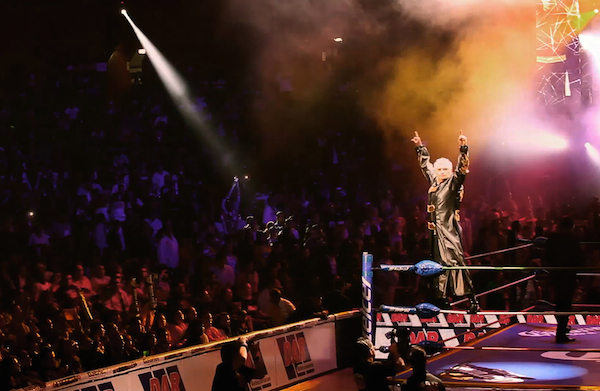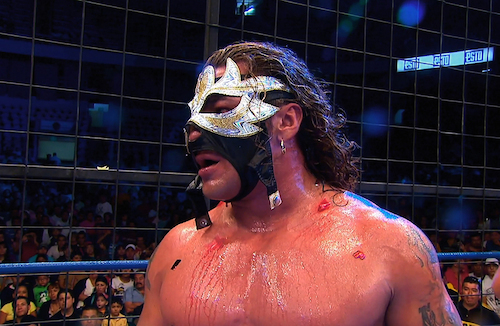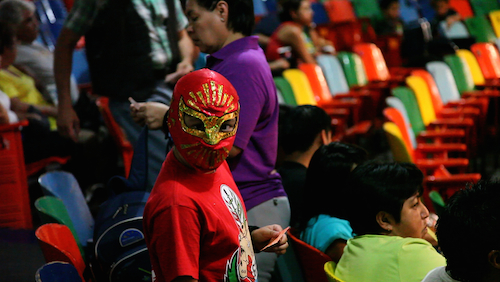Life of the Luchador, In and Out of the Ring
The new documentary Lucha Mexico is an entertaining, enlightening and, ultimately, poignant look at Lucha Libre, the colorful, acrobatic form of professional wrestling that has been popular in Mexico for decades. Filmmakers Alex Hammond and Ian Markiewicz give us a truly inside view of the sport and its wildly popular superhero personalities, its intense physical demands and its widespread influence throughout the country. Even nonfans of spectacle wrestling can appreciate this in-depth look at the longtime phenomenon and its myriad masked players.
From the get-go, the filmmakers take us right into the ring for up-close scenes of amusing and highly energetic matches featuring dramatic, larger-than-life (in some cases, literally) stars cheered on by thousands of adoring fans. We also see glimpses of life outside of the arena, as the luchadores train, meet fans, and talk about their lives. One of the film’s main spotlights follows the popular and likeable Shocker, who is used as a sort of guide through Lucha Libre, as we see him working out, posing for fan photos, touring the country to compete in matches big and small, and receiving brutal-looking medical treatments for a devastating knee injury (he opens a restaurant during his recovery). Former strength competitor Jon “Strongman” Andersen provides another veteran point of view, as he talks matter-of-factly about the realities of the profession. We also see him in various settings, including home with family and at the gym, where he hoists insanely heavy barbells to maintain his mountainous physique. Eventually, he too suffers an injury that forces him into temporary retirement.
We’re introduced to several other leading luchadores, including those from wrestling dynasties, such as Blue Demon, Jr. (who has never been seen in public unmasked) and the tragic, charismatic El Hijo Del Perro Aguayo, founder of the Perros Del Mal, infamous for violently hardcore matches. Others, like Fabian “El Gitano,” a former Chippendales dancer, come from non-wrestling backgrounds, all of them embracing the passion and dedication necessary to make it to the “major leagues,” i.e., the CMLL (Consejo Mundial De Lucha Libre), founded in 1933 and the oldest still-operating wrestling promotion in the world, or the newer AAA. We also watch equally buff female luchadoras Faby Apache and her main rival Sexy Star, who prays before every match and claims that Lucha Libre saved her from crippling depression. Interestingly, there are Catholic shrines set up in several arenas and one match is hosted by a religious festival. Such is the place of wrestling in Mexican culture.
Much of the action takes place at the unofficial home of Lucha Libre, Mexico City’s historically significant Arena Mexico, and the filmmakers take us to other enormous arenas that have been built specifically for the sport. Apparently, big matches no longer take place in the country’s most crime-ridden cities (including Tijuana and Matamoros), where once-thriving arenas have been closed.
We learn that wrestlers choose between two character types: Tecnicos, good guys who play by the rules and are cheered by the crowds; and Rudos, dirty fighters who are happily booed. (A popular chant at matches: “Asshole! Asshole!”) There’s also the definitive luchador challenge: Mask Vs. Mask, in which the loser suffers the ultimate humiliation of forced unmasking (a fate that proved devastating for the deceptively sensitive “El Gitano”).
All this is presented with maximum, you-are-in-the-ring action, as we feel the crowd’s excitement and the wrestlers’ sweat and strain. We want to be horrified by the “abuse” of beloved mascot Kemonito, a dwarf in a fuzzy monkey suit who is routinely tossed around like a stuffed animal, but reluctantly appreciate the fact that he’s a respected working luchador who seems happy in his profession. On the other hand, the ruthless Perros del Mal matches shown on screen are truly disturbing.
Whatever ideas one may have had about Lucha Libre going into this film, it’s hard not to come away impressed by the drive and commitment of these masked athletes, with their broken down bodies, whether they’re performing in a huge, slick arena or delighting children in some makeshift rural set-up. Though they obviously get off on the fame (and undoubtedly the money) involved, it’s clear there’s some kind of higher calling pulling them into the ring.
Lucha Mexico opens on Friday at Nitehawk Cinema and IFC Center.
—Marina Zogbi




